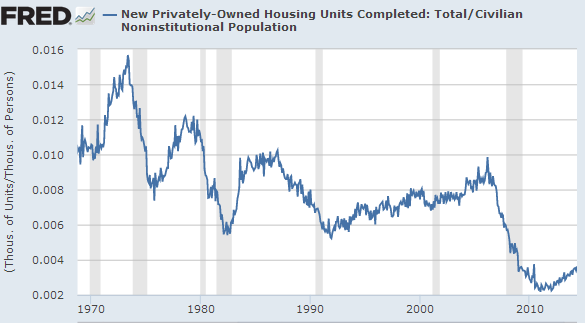The US is facing a new housing crisis. No, it has nothing to do with subprime mortgages or bloated home equity balances. This time the nation is dealing with shortages of rental housing, a problem that will become increasingly acute in years to come and may result in a material drag on economic growth.
Americans are simply not building enough homes to accommodate the population’s needs. The number of housing units completed per capita in the United States remains a fraction of historical averages. The slight improvements from the lows of 2011 have barely scratched the surface.
Â

Similarly, in spite of recent increases, residential construction spending as a fraction of the GDP remains at the lowest levels than at any time since WWII.
Â

At the same time demand has been on the rise. As an indicator, the chart below shows Google search frequency for rent related phrases.
 |
| Apartments & Residential Rentals – related searches (Source: Google Insights) |
The myth out there is that this problem is somehow limited to some of the coastal areas of the United States – NY, Florida, California, etc. It is not. Just take a look at the rental vacancy trend in the Midwest.Â
Â
 |
| The last point represents Q1, 2014 |
This shortage is of course is translating into rising costs of shelter across the country. The overall shelter CPI is headed toward 3% and the rate of just rental cost increases is even higher. It is materially above the overall CPI rate and expected to rise further.
Â

This trend, combined with massive amounts of student debt (see discussion)Â will be increasingly taking a bite out of consumer spending. The percentage of “housing cost burdened” households (those who spend more than 30% of their income on shelter) has been rising rapidly.
JCHS (Harvard) – The recent deterioration in rental affordability comes after a decade of lost ground. The share of cost-burdened renters increased by a stunning 12 percentage points between 2000 and 2010, the largest jump in any decade dating back at least to 1960. The cumulative increase in the incidence of housing cost burdens is astounding. In 1960, about one in four renters paid more than 30 percent of income for housing. Today, one in two are cost burdened. Even in 1980, following two decades of worsening affordability, the cost-burdened share of renters was just above a third.

